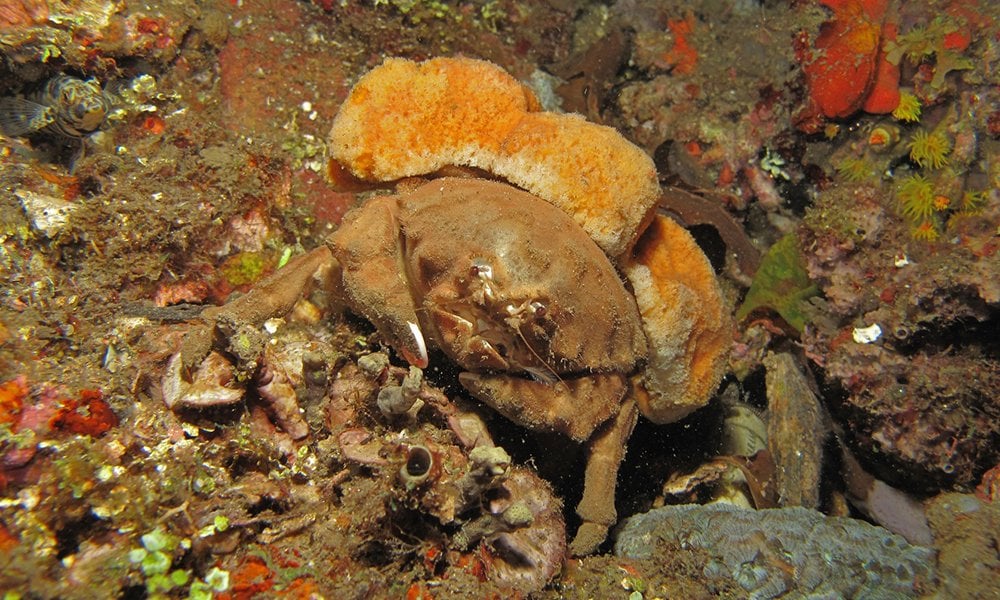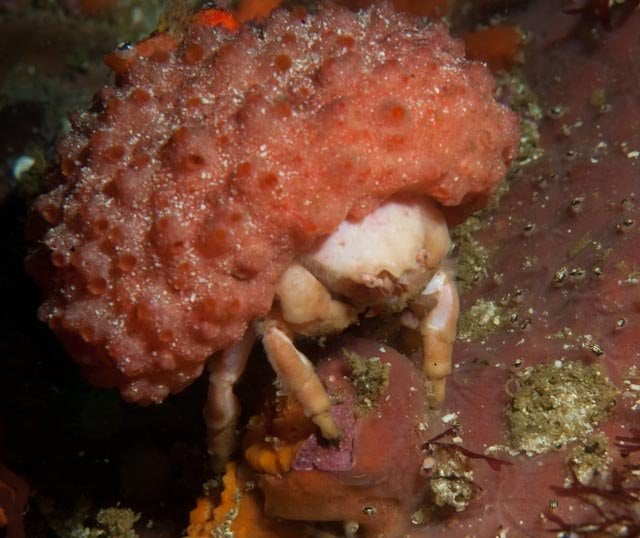The crabs that wear sea sponges like a hat

CHANCES ARE YOU’VE NEVER spotted a sponge crab, but if you had, you wouldn’t be forgetting their wacky appearance any time soon.
While other crabs rely on their hard shells, intricate patterns and pincers for protection, these crabs use live sponges – fashioning them to their body and holding them in place like colourful hats.
“Many predators have evolved methods of getting into even the most solid crabs, so the sponge crabs have evolved to carry large pieces of camouflage to prevent being spotted by predators such as fish, octopus and other crabs,” explains Andrew Hosie, curator of Crustacea at the WA Museum.
“The sponge isn’t just a disguise, as they are well known for having a very good set of chemical defences to protect themselves from predation. Many produce toxins or otherwise obnoxious chemicals to deter predators – this provides added protection to the crab.”

Sponge crabs ‘wear’ live sea sponges for protection. (Image: Bernard Dupont/Wikimedia)
It is a relationship providing much aid to the crab, but although the sponge remains living – it is unclear whether they reap many benefits from their new, mobile host.
And the relationship is not limited to a certain sponge species, these crabs have been known to wear (and replace periodically) sponges of all shapes, colours and sizes – often with quite humorous results.
“Some species of sponge crabs show a preference for particular sponge species, but it doesn’t seem to be very strict in general, some will even use colonial ascidians as well as sponges,” Andrew says. “The key character the crabs are looking for is that the sponge is malleable enough to snuggly fit on their back.”
Common but camouflaged
Australia’s coastline is home to 30 species of these striking crustaceans – with more no doubt yet to be discovered – found alongside sponges in shallow waters to depths of 500m, with the most diversity in the tropics.
However despite being common, they are difficult to spot – owing to their deceptive headwear, typically nocturnal behaviour and rare ventures into intertidal zones.
“The sponge is excellent camouflage and I’ve only stumbled across them by accident unless they’ve been sitting on a sponge with a contrasting colour to their own,” Andrew says.
RELATED: Australia’s curious crabs
They are certainly not alone in their quest for camouflage using external sources, with a number of other crustaceans using seaweed and shells (think hermit crabs) to mask their identity on the sea floor.
And while the benefits in camouflage are clear, it is not known whether sponge selection plays a role in breeding.
“A very interesting study would be to see if females prefer males with a particular type or shape of sponge,” Andrew says.

Furred sponge crab. (Image: Seascapeza/Wikimedia)
Weird and wonderful crustaceans
From our coastlines, freshwater rivers and lakes, to the arid Pilbara, a diverse array of crustaceans are found throughout Australia – many of them unique and unusual in their nature.
And amongst this highly diverse group of invertebrates – which includes shrimp, slaters and barnacles among others – Andrew says sponge crabs “hold a special place in the crab family tree”.
The sponge crab family (Dromiidae) is considered one of the most primitive groups of the true crabs, with remnants of a tail fan (seen in lobsters and shrimp) and more primitive reproductive biology in females.
“While their anatomy is certainly very interesting for how they are evolutionarily related to other crustacea, it is certainly their behaviours and quite comical appearance that makes me interested in them,” Andrew explains.
“They always appear to have a very grumpy-looking face poking out from under the sponge cap, and they also seem a bit clumsy walking around under water – most probably due to the oversized hat.”
READ MORE:
- March of the Christmas Island crabs
- Gallery: bizarre marine creatures
- Orangutan crab a dedicated decorator




